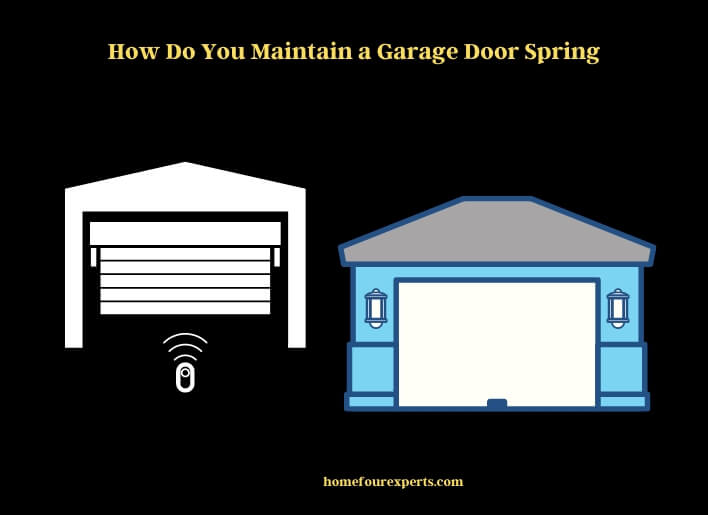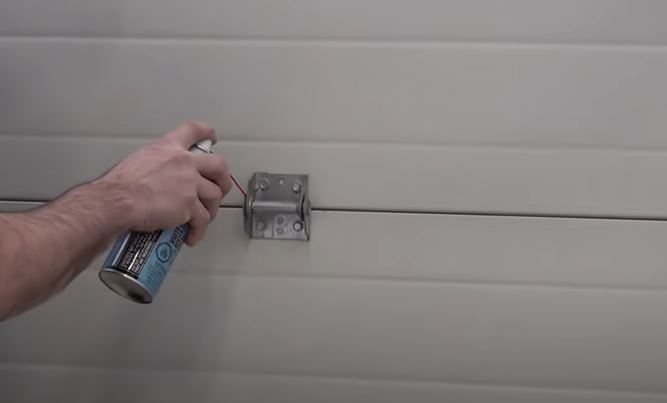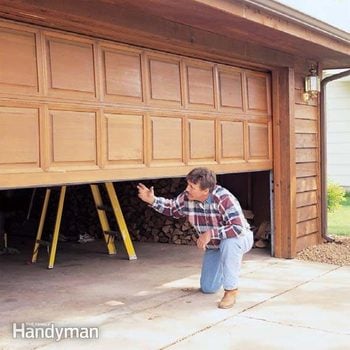If your garage door spring is broken, you will need to replace it. However, if it is just starting to show signs of wear and tear, you may be able to extend its life with some basic maintenance. First, check the springs for rust and corrosion.
If they are beginning to rust, you can try wire brushing them clean and then applying a coat of Rust-Oleum paint. This will help protect the springs from further corrosion.

If your garage door has a spring system, it’s important to know how to maintain it. Garage door springs are under a lot of tension and can be dangerous if they’re not maintained properly. Here are some tips for maintaining your garage door springs:
| 1 | Check the springs regularly for wear and tear. If you see any damage, replace the springs immediately. |
| 2 | Lubricate the springs with a silicone-based lubricant every few months. This will help keep them working smoothly and prevent rusting. |
| 3 | If your garage door is equipped with torsion springs, make sure to have them serviced by a professional every few years. |
How to Lubricate Garage Door Springs?
If your garage door is making creaking or grinding noises when you open and close it, chances are the springs need to be lubricated. Lubricating your garage door springs can help keep them from rusting and wearing out prematurely. Here’s how to do it:
1. Type of Spring System
First, identify which type of spring system your garage door has. There are two types: torsion springs (mounted above the door) and extension springs (mounted on either side of the upper tracks).
2. Use a Ladder
If you have torsion springs, use a ladder to reach the spring on either side of the door.
Apply a few drops of light oil (such as 3-in-1 oil) to each spring, being careful not to get any oil on the cables or pulleys. Then, use a rag to wipe away any excess oil.
3. Disconnecting the Safety Cable
If you have extension springs, start by disconnecting the safety cable that runs through both springs (this will prevent the springs from snapping if they break while you’re working on them).
Next, use a stepladder to reach one of the springs and apply a few drops of light oil before using a rag to wipe away any excess. Repeat this process for the other spring. Once you’re finished, reattach the safety cable before operating your garage door as usual.
How to Lubricate Garage Door Opener Chain?
If your garage door opener has a chain, it will need to be lubricated from time to time to keep it running smoothly. Here’s how to do it:
| 1 | Locate the chain on your garage door opener. It should be located near the bottom of the unit. |
| 2 | Apply a few drops of lubricant to the chain, using a rag or your finger to spread it evenly. |
| 3 | Wipe away any excess lubricant with a clean rag. |
| 4 | Test the garage door opener to make sure it’s working properly. |
Should I Lubricate the Garage Door Spring?
If your garage door is making noise or not working as smoothly as it used to, you may need to lubricate the springs. Garage door springs are under a lot of tension and can benefit from a little extra lubrication. You can use a variety of products to lubricate your garage door springs, but make sure to choose one that won’t damage the finish on your door.
To lubricate your garage door springs, start by spraying them with WD-40 or another penetrating oil. Then, use a rag to wipe away any excess oil. For best results, do this every few months or whenever you notice the performance of your door declining.
Garage Door Lubricant

When it comes to maintaining your garage door, one of the most important things you can do is keep it well-lubricated. Garage door lubricant helps to keep all of the moving parts working smoothly and prevents rust and other damage. There are a few different types of lubricants that you can use on your garage door, so it’s important to choose the right one.
WD-40 is a popular choice for garage doors because it’s easy to find and relatively inexpensive. However, WD-40 is not actually a true lubricant, so it’s not the best choice for long-term use. It can also attract dirt and dust, which can eventually lead to clogs in the moving parts.
A better option is a silicone-based lubricant, which will last longer and won’t attract as much dirt and debris. You can find silicone-based lubricants at most hardware stores. Once you have your lubricant, apply it to all of the moving parts on your garage door, including the hinges, rollers, tracks, and springs.
Be sure to wipe away any excess before operating the door. It’s also a good idea to check these parts regularly (about once per month) and reapply as needed. By keeping your garage door well lubricated, you can help extend its life and keep it running smoothly for years to come!
Should I Oil the Chain on My Garage Door Opener?
If you have a garage door opener, it’s important to keep the chain oiled. A garage door opener consists of many moving parts, and the chain is one of the most important. The chain helps raise and lower the door, and if it isn’t properly lubricated, it can cause the door to malfunction.
There are two types of chains used in garage door openers: roller chains and tension-type chains. Roller chains are more common and require less maintenance than tension-type chains. However, both types of chains need to be lubricated regularly.
To lubricate a roller chain, simply apply a few drops of oil to each link. You can use any type of oil, but motor oil is typically best. Apply the oil to the inside and outside of each link.
Then run the chain through your fingers to work the oil into all the links. Wipe off any excess oil with a rag so it doesn’t get on your floor or clothing. Tension-type chains are slightly more complicated to lubricate because they’re under tension when they’re not being used.
To lubricate a tension-type chain, first, release the tension by pulling on the red cord that’s attached to the door opener (this should be done when the door is closed). Then apply a few drops of oil to each link as you did with the roller chain. Again, wipe off any excess oil so it doesn’t get on anything else.
It’s important to keep your garage door opener’s chain properly lubricated so it continues working correctly for years to come!
How to Clean Garage Door Tracks?
If your garage door tracks are starting to look a little dirty or rusty, it’s time to give them a good cleaning. Here’s how:
1. Giving the Tracks a Good Visual Inspection
Start by giving the tracks a good visual inspection. Look for any dirt, debris, or rust that needs to be removed.
2. Use a Vacuum Cleaner
If there is any loose dirt or debris, use a vacuum cleaner with a brush attachment to remove it from the tracks.
3. Stiff Bristled Brush
For tougher dirt or grime, you may need to use a stiff bristled brush and some elbow grease to get the tracks clean.
Be sure to rinse away any soap residue afterward.
4. Rollers on Your Garage Door
Take a look at the rollers on your garage door too. These can also become dirty or gummed up over time, so they may need to be cleaned as well.
Simply remove them from the tracks and clean them with a damp cloth before putting them back in place.
5. Apply Some Lubricant
Once everything is clean and dry, apply some lubricant ( WD-40 is fine) to the tracks and rollers.
This will help keep everything running smoothly and prevent future build-up of dirt and debris.
How Often to Lubricate Garage Door?
If you have a garage door, you know that it’s important to keep it lubricated in order to keep it working properly. But how often should you be lubricating your garage door?
The answer may surprise you – most experts recommend that you lubricate your garage door at least once a month.
That might seem like a lot, but when you think about all the moving parts on your garage door, it makes sense. A little bit of lubricant can go a long way in keeping your door operating smoothly.
There are a few different ways to lubricate your garage door.
You can use WD-40, which is always a good option for getting rid of rust and grime. Or, you can use a silicon-based spray lubricant. Whichever method you choose, just be sure to get all the nooks and crannies of your door so that everything is well-lubricated.
Keeping your garage door properly lubricated is an easy way to extend its life and keep it running smoothly. So be sure to add this simple task to your monthly home maintenance checklist!
Best Lubricant for Garage Door Springs And Rollers
If you have a garage door, then you know how important it is to keep the door in good working order. This means that you need to regularly lubricate the door and its parts. One of the most important parts to lubricate are the springs and rollers.
Springs: Garage doors have either torsion or extension springs. It is important to lubricate these every few months to prevent rust and wear. You can use WD-40, white lithium grease, or even silicone spray.
Just make sure that you do not get any of this on the plastic parts of the door as it can cause them to break down.
Rollers: The rollers on your garage door need to be kept lubricated as well. You can use WD-40, white lithium grease, or even silicone spray for this as well.
Make sure that you do not get any of this on the plastic parts of the door as it can cause them to break down.

Are You Supposed to Lubricate Garage Door Springs?
If you have a garage door, chances are you have springs. These springs help to counterbalance the weight of your door so that it can be opened and closed with ease. While they are built to last, over time they can become worn down and need to be replaced.
But before you do that, you may be wondering if you should lubricate them first.
The answer is yes, you should lubricate your garage door springs on a regular basis. This will help to keep them in good shape and working properly for longer.
The best time to do this is every few months or so. All you need is a little bit of WD-40 or another type of light oil. Just apply it to the spring itself (being careful not to get any on the surrounding areas) and then work it in by moving the spring back and forth a few times.
It’s important to note that while lubricating your springs can help extend their life, it’s not a cure-all solution. Eventually, they will need to be replaced. But by keeping them well-lubricated, you can help ensure that they last as long as possible.
How Often Should You Lubricate Garage Door Springs?
If your garage door springs are squeaking or beginning to show signs of wear and tear, it’s time to lubricate them. But how often should you do this? Ideally, you should lubricate your garage door springs at least once a year.
This will help keep them in good condition and prevent rust and corrosion from setting in. To lubricate the springs, simply apply a light coating of WD-40 or another suitable lubricant. You don’t need to use a lot – just enough to make the surface wet.
Then operate the door a few times to spread the lubricant around. If your springs are particularly old or damaged, you may need to replace them rather than just lubricating them. However, if they’re still in good condition, simple annual lubrication should be all that’s needed to keep them working smoothly for years to come.
What is the Best Lubricant for Garage Door Springs?
If you have a garage door, chances are that you have springs. Garage door springs are an important part of the door’s operation and need to be lubricated periodically to keep them working properly. But what is the best lubricant for garage door springs?
There are many different types of lubricants on the market, but not all of them are created equal. Some lubricants can actually damage your springs, so it’s important to choose one that is specifically designed for use on garage door springs. Spray-on lubricants are generally the easiest to use and provide good coverage.
However, they can also be messy and difficult to control. If you opt for a spray-on lubricant, be sure to follow the directions carefully and only apply it to clean dry surfaces. Grease is another option for lubricating your garage door springs.
It’s easy to apply and provides long-lasting protection against rust and corrosion. However, grease can attract dirt and dust, which can eventually cause your springs to fail prematurely. For this reason, it’s important to keep your springs clean and free of debris before applying any grease.
Oil-based lubricants offer excellent protection against rust and corrosion but can be messy to work with. If you choose an oil-based lubricant, be sure to wipe up any excess with a clean cloth after application.
Can I Use Wd-40 on Garage Door Spring?
If you have a garage door with springs, you may be wondering if WD-40 is a good option for lubricating them. The answer is yes, you can use WD-40 on garage door springs. However, it’s important to note that WD-40 is not a long-term solution and should only be used as a temporary fix.
Over time, the WD-40 will evaporate and will need to be reapplied. For best results, use WD-40 on your garage door springs every few months.
Last Remarks
It’s no secret that garage door springs are essential to the function of your garage door. In fact, these springs are so important that they are often referred to as the “heart” of the garage door. So, it’s critical that you maintain your garage door springs in good working condition.
There are two types of garage door springs – torsion springs and extension springs. Torsion springs are located above the opening of your garage door while extension springs can be found along the side of the door.
Both types of springs work together to assist in opening and closing your garage door.
Over time, however, these springs can become worn out or broken. That’s why it’s important to inspect them on a regular basis and make sure they are still in good shape.
If you notice any damage or wear and tear on your garage door spring, it’s best to replace it right away.
This may seem like a daunting task, but it’s actually quite simple if you have the right tools and instructions. You can also find many helpful videos online that will show you how to replace your own garage door spring.
Used References:
- https://www.wikihow.com/Lubricate-a-Garage-Door
- https://www.ehow.com/how_12158407_lubricate-chaindriven-garage-door-opener.html
About This Writer

Hi, I am Eric Devin and I am a professional interior architect. Since childhood, I've always enjoyed DIY projects! And, I have loved to solve simple household problems using essential tools and equipment. I have also acquired a lot of information about basic household tools settings by working with contractors.